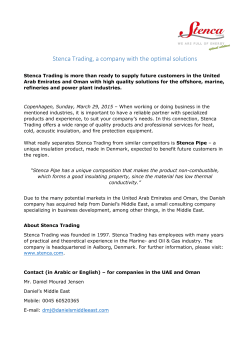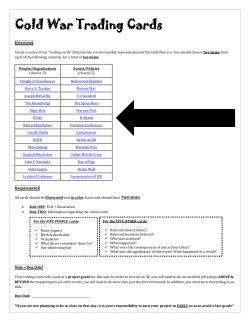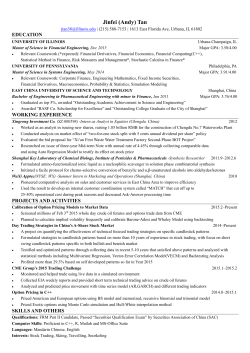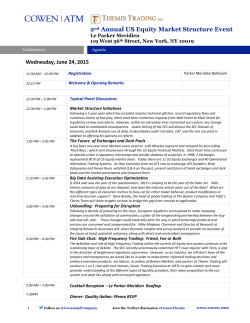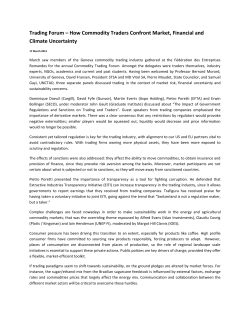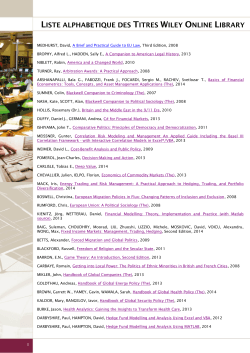
Government-Endorsed Fiat Money: Natural Monopoly in a Trading
”Government-Endorsed Fiat Money:
Natural Monopoly in a Trading Post
Economy”
1
Why is there Money?, Elgar 2012, Chapter 8
(augmented)
Ross M. Starr
University of California, San Diego; April 6, 2015
”[An] important and difficult question...[is] not answered by the approach
taken here: the integration of money in the theory of value...”
—— Gerard Debreu, Theory of Value (1959)
Abstract
In a trading post model of N commodities there are 12 N(N − 1)
commodity-pairwise trading posts. Taxation — and fiat money’s
guaranteed value in payment of taxes — explains the positive equilibrium value of fiat money. A bid/ask spread at each trading post
reflects transaction costs incurred at the post. Government’s large
scale interacting with scale economies in transaction costs make
fiat money the low-transaction-cost medium of exchange, resulting in fiat money being the unique medium of exchange in general
equilibrium. Fiat money equilibrium is characterized by all trade
concentrated on the trading posts trading the N commodities for
fiat money; the remaining barter trading posts are priced but inactive in equilibrium.
1
This essay includes Chapter 8 of ”Why is there Money?” augmented by selections from
other chapters to allow the presentation to be self-contained.
1
A Challenge
During the 1970s at Yale’s Cowles Foundation, the most serious scientific conversations took place in the coffee lounge. As a junior colleague then in the
company of leading monetary economists Tobin, Brainard, Wallich, I remember a discussion of inflation. One colleague said ”Well, Herb Scarf (a general equilibrium theorist) says ....” Bill Brainard replied, ”But Herb can only
give you relative prices. He doesn’t have a monetary model.” Indeed, it was
generally viewed then as impossible to derive a monetary theory from the
Arrow-Debreu general equilibrium model. Brainard’s remark echoed decades
of tradition as Hicks (1935) and Tobin (1960) had challenged microeconomic
theory to present a sound account of money.
Hahn (1982) who had made so much progress was not sanguine ”The ...
challenge that ... money poses to the theorist is this: the best developed
model of the economy cannot find room for it. The best developed model is,
of course, the Arrow-Debreu version of a Walrasian general equilibrium.”
What puzzles must a price-theoretic fundamental model of money resolve?
• Trade is monetary. One side of almost all transactions is the
economy’s common medium of exchange.
• Money is (virtually) unique. Though money differs among economies,
almost all the transactions in most places most of the time use a
single common medium of exchange.
• Even transactions suitable for barter resolution, displaying a double coincidence of wants, are transacted with money.
• Money is government-issued fiat money, trading at a positive
value though it conveys directly no utility or production.
The mission of the present essay is to formulate a parsimonious model
in the Arrow-Debreu tradition that nevertheless derives government-issued
fiat money as the universal common medium of exchange as the result of
elementary considerations. Money is an outcome of the equilibrium, not an
assumption.
1
The Trading Post Model
The trading post model consists of N commodities traded pairwise at
2
1
N(N − 1)
2
trading posts with distinct bid and ask prices reflecting transaction
costs. Households create trading plans to optimize utility subject to prevailing
prices and subject to a budget constraint at each post. A barter equilibrium
will occur if most trading posts are active in equilibrium — most goods trading
directly for most other goods. A monetary equilibrium occurs if active trade
is concentrated on a few trading posts, those trading the common medium of
exchange against most other goods.
The trading post model decomposes the trading plans of each household
into many separate transactions. The pattern of active trade is endogenously
determined as part of the equilibrium of the trading post economy.
Walras (1874) forms the picture this way (assuming m distinct commodities):
”we shall imagine that the place which serves as a market for the exchange of all the commodities (A), (B), (C), (D) ... for one another
is divided into as many sectors as there are pairs of commodities
special markets each idenexchanged. We should then have m(m−1)
2
tified by a signboard indicating the names of the two commodities
exchanged there as well as their ... rates of exchange...”
Starting from the non-monetary Arrow-Debreu model, two additional structures are sufficient to give endogenous monetization in equilibrium: multiple
budget constraints (one at each transaction, not just on net trade) and transaction costs. The choice of which trading posts a typical household will trade at
is part of the household optimization. The equilibrium structure of exchange
is the array of trading posts that actually host active trade. The determination of which trading posts are active in equilibrium is endogenous to the
model and characterizes the monetary character of trade. The equilibrium is
monetary with a unique money if only (N -1) trading posts are active, those
trading all goods against ‘money.’
Let there be N commodities, numbered 1, 2, ..., N. Goods are are traded
in pairs — good i for good j — at specialized trading posts. The trading
post for trade of good i versus good j (and vice versa) is designated {i, j };
trading post {i,j } is the same trading post as {j, i } . {i, j } actively buys
and (re)sells both i and j. Trade as a resource using activity is modeled by
describing the post’s transaction costs. The bid/ask spread summarizes these
costs to trading households. The trading post itself operates at zero profit.
C {i,j} is trading post {i,j}’s transaction cost.
3
h
A typical household h ∈ H, has an endowment rh ∈ RN
+ ; rn is h’s endowment of good n. Households formulate their trading plans deciding how much
of each good to trade at each pairwise trading post.
h,{i,j}
b`
= planned purchase of good ` by household h at trading post {i, j}.
h,{i,j}
s`
= planned sale of good ` by household h, at trading post {i, j}
The bid prices (the prices at which the trading post will buy from house{i,j}
{i,j}
holds) at {i, j} are qi , qj
for goods i and j respectively. The price of i is
in units of j. The price of j is in units of i. The ask price (the price at which
the trading post will sell to households) of j is the inverse of the bid price of i
{i,j}
{i,j}
(and vice versa). That is, (qi )−1 and (qj )−1 are the ask prices of j and i
at {i, j}. The trading post {i, j} covers its costs by the difference between the
{i,j}
{i,j}
bid and ask prices of i and j, that is, by the spread (qj )−1 − qi
and the
{i,j} −1
{i,j}
spread (qi ) − qj . Transaction costs at the trading post are incurred
in goods i and j, acquired in trade and defrayed through the difference in bid
and ask prices.
{i,j} {i,j}
Given qi , qj , for all {i, j}, household h then forms its buying and
selling plans, in particular deciding which trading posts to use to execute
his desired trades. Household h ∈ H faces the following constraints on its
transaction plans.
Trading Post Balance Constraints:
(T.i) bnh{i,j} > 0 only if n = i, j; snh{i,j} > 0 only if n = i, j.
h{i,j}
(T.ii) bi
{i,j}
≤ qj
(T.iii) xhn = rnh +
h{i,j}
· sj
P
h{i,j}
,
h{i,j}
{i,j} bn
bj
−
P
{i,j}
{i,j}
≤ qi
h{i,j}
· si
for each {i, j}.
snh{i,j} ≥ 0, 1 ≤ n ≤ N.
Note that condition (T.ii) defines a budget balance requirement at the
transaction level, implying the decentralized character of trade. Since the
budget constraint applies to each pairwise transaction separately, there may
be a demand for a carrier of value to move purchasing power between distinct
{i,j} {i,j}
transactions. h faces the array of bid prices qi , qj
and chooses snh{i,j}
and bnh{i,j}, n = i, j, i, j = 1, 2, . . . , N, i 6= j, to maximize uh (xh ) subject to
(T.i), (T.ii), (T.iii). That is, h chooses which pairwise markets to transact in
and a transaction plan to optimize utility, subject to a multiplicity of pairwise
{i,j}B
{i,j}S
budget constraints. yi
denotes trading post {i,j}’s purchase of i. yi
denotes its sale of i.
o{i,j}
o{i,j}
A market equilibrium consists of qi
, qj
, 1 ≤ i, j ≤ N, so that :
4
• For each household h ∈ H, there is a utility optimizing plan bnoh{i,j},
P
P
snoh{i,j} , (subject to T.i, T.ii, T.iii) so that h bnoh{i,j} = yno{i,j}S , n snoh{i,j} =
yno{i,j}B , n = i, j, for each {i, j}, each n, where
• yno{i,j}S ≤ yno{i,j}B , n = i, j.
o{i,j}B
• yi
o{i,j}S
− yi
o{i,j}B
+ yj
o{i,j}S
− yj
= C {i,j} for all 1 ≤ i, j ≤ N, i 6= j.
The expression in the last bullet is a zero profit condition.
An equilibrium is said to be monetary with a unique money, µ, if — for
all households — good µ is the only good that a household will both buy and
sell.
2
The Most Saleable Good
The most elementary function of money — the medium of exchange — is as
a carrier of value held between successive transactions. Carl Menger (1892)
reminds us that the distinguishing feature of the medium of exchange should
be liquidity:
why...is...economic man ...ready to accept a certain kind of commodity, even if he does not need it, ... in exchange for all the goods
he has brought to market[?]... The theory of money necessarily presupposes a theory of the saleableness [Abs¨atzfahigkeit] of goods ...
[Call] goods ... more or less saleable, according to the ... facility with which they can be disposed of ... at current purchasing
prices or with less or more diminution... Men ... exchange goods
... for other goods ... more saleable....[which] become generally
acceptable media of exchange. [emphasis in original]
”Saleableness” is liquidity. Though Menger notes many dimensions to liquidity (delay, uncertainty, search, ...), a simple characterization is the difference between the bid price and the ask price. A commodity that acts as a
medium of exchange is necessarily repeatedly bought (accepted in trade) and
sold (delivered in trade). Therefore a good with a narrow spread between bid
and ask price is priced to encourage households to use it as a carrier of value
between trades, as a medium of exchange with relatively low cost.
5
3
Fiat Money
In order to study fiat money we introduce a government with the unique power
to issue fiat money. Fiat money is intrinsically worthless; it enters no one’s
utility function. But government is uniquely capable of declaring it acceptable
in payment of taxes. Adam Smith (1776) notes “A prince, who should enact
that a certain proportion of his taxes be paid in a paper money of a certain
kind, might thereby give a certain value to this paper money.” (v. I, book II,
ch. 2).
G. F. Knapp’s Staatliche Theorie des Geldes (1923) says ”Money is a creature of law...First and foremost, money frees us from our debts toward the
state; for the state in emitting it, acknowledges that, in receiving, it will accept this means of payment.”
Abba Lerner (1947) comments,
The modern state can make anything it chooses generally acceptable as money and thus establish its value quite apart from any
connection, even of the most formal kind, with gold or with backing of any kind. It is true that a simple declaration that such and
such is money will not do, even if backed by the most convincing constitutional evidence of the state’s absolute sovereignty. But
if the state is willing to accept the proposed money in payment
of taxes and other obligations to itself the trick is done ... On the
other hand if the state should decline to accept some kind of money
in payment of obligations to itself, it is difficult to believe that it
would retain much of its general acceptability.
Taxation — and fiat money’s guaranteed value in payment of taxes —
explains the positive equilibrium value of fiat money. That fiat money is legal
tender is essentially meaningless without a guarantee of the price at which it
may be tendered. But acceptability in payment of taxes at a fixed rate creates
a market-based value. Government’s large scale along with scale economies in
transaction costs explain fiat money’s uniqueness as the medium of exchange.
As an economic agent, government is denoted G. Government sells tax
receipts, the N +1st good. It also sells good N+2, an intrinsically worthless instrument, (latent) fiat money, that government undertakes to accept in
payment of taxes, that is, in exchange for N + 1.
6
4
Households
Let N ≥ 3. Ω denotes the greatest integer ≤ (N − 1)/2.
Let [i,j] denote a household endowed with good i who prefers good j; i 6= j,
i,j = 1, 2, ..., N. Household [i,j] ’s endowment is A of commodity i. Denote the
[i,j]
endowment of [i,j] as ri = A. [i,j]’s utility function is u[i,j] (x1, x2, x3 , ..., xN ) =
xj . That is, household [i,j] values good j only. He cares for i only as a resource
to trade for j. This is obviously an immense oversimplification — but it serves
to focus the issue.
Consider a population denoted Θ of households displaying a complete absence of double coincidence of wants. Assume that there are Ω households
endowed with each good and each household desires a good different from its
endowment. There are Ω households endowed with good 1, preferring respectively, goods 2, 3, 4, ..., Ω + 1: [1,2], [1,3], [1,4], ..., [1,Ω + 1]. There are
Ω households endowed with good 2, preferring respectively goods 3, 4, 5, ...,
Ω + 2: [2,3], [2,4], [2,5], ..., [2,Ω + 2]. The roll call of households proceeds so
forth, through [N, 1], [N, 2], [N, 3], ..., [N,Ω].
One way to think of Θ is that its elements [i, j] are set round a clock-face
at a position corresponding to the endowed good, i, eager to acquire j. j
being 1, 2, ... , Ω, steps clockwise from i. Population Θ displays absence of
the ”double coincidence of wants” that Jevons (1875) posits allows successful
barter. In this example, for each household endowed with good i and desiring
good j, [i,j], there is no precise mirror image, [j,i]. Nevertheless, there are
Ω households endowed with A of commodity 1, and Ω households strongly
preferring commodity 1 to all others. That is true for each good. Thus gross
supplies equal gross demands, though there is no immediate opportunity for
any two households to make a mutually advantageous trade. Jevons (1875)
tells us that this is precisely the setting where money is suitable to facilitate
trade.
We modify Θ very slightly to take account of taxes, denoting it ΘT . The
typical household [i, j] in ΘT desires to purchase tax receipts to the extent it
prefers not to have a quarrel with the government’s tax authorities. Government sets a target tax receipt purchase by the taxpayer of τ [i,j] . Then we
rewrite [i, j]’s utility function as
[i,j]
u[i,j](x) = xj − 2[max[(τ [i,j] − xN +1), 0]]
UT
(1)
That is, household [i, j] values paying his taxes with a positive marginal utility
up to his tax bill τ [i,j] and with zero marginal utility for tax payments there7
after. Government uses its revenue to purchase a variety of goods n = 1, ..., N,
in the amount xG
n.
Good N+2 good represents latent fiat money. Government, G, sells N+1
(tax receipts) for N+2 at a fixed ratio of one-for-one. The trading post {N+1,
N+2} where tax receipts are traded for N+2 operates with zero transaction
cost. Acceptability in payment of taxes ensures N+2’s positive value. If, in
addition, N+2 is assumed to have sufficiently low transaction cost, then it
becomes the common medium of exchange.
5
Transaction Costs and Monetary Equilibrium
For the model with taxation, define the linear transaction cost in the following
way.
Definition: T-system transaction cost
C {i,j} = δ×(volume of goods i and j purchased by the post)
Marginal cost of trading i for j is δ times the gross quantity traded.
Trading good N + 2 is assumed to be costless. Thus,
C {N +2,j} = δ×(volume of good j purchased by the post), for j = 1, 2, . . . , N.
That is, δ = δ i, i = 1, 2, . . . , N, δ N +2 = 0.
Finally, the tax payment is assumed to be have zero transaction cost.
C {N +1,N +2} = 0.
Proposition 8.1: Let the population of households be ΘT . Let u[i,j]
be described by (UT). Let τ 0 > 0 be a constant. Let 0 < τ [i,j] = τ 0 <
0 {N +2,n}
A(1 − δ N +2)(1 − δ i ), all [i, j] ∈ ΘT . Let xG
all n = 1, 2, ...N.
n = Ωτ qN +2
{i,j}
Let C
be the T-system transaction cost. Then the unique average cost
(and marginal cost) pricing equilibrium is a monetary equilibrium with good
N + 2 as the common medium of exchange.
{N +1,N +2}
{N +2,j}
Demonstration of Proposition : qN +2
= 1. qj
= 1−δ, for all j =
{N +2,j}
{i,j}
1, 2, . . . , N. qN +2
= 1, for all j = 1, 2, . . . , N. qj
= (1 − δ)2, for all i 6=
j, i, j = 1, 2, . . . , N. Hence, all trade in j = 1, 2, . . . , N goes through trading
posts {j, N + 2} as the low cost venue.
8
Defintion: TCNC-T, scale economy transaction cost with taxation
The nonconvex (scale economy) cost function2 for trading post {i, j}, i, j =
1, 2, . . . , N, N + 2 is
{i,j}B
{i,j}B
C {i,j} = min[δ iyi
, γ i ] + min[δ j yj
, γj ]
(TCNC-T)
{N +1,j}
j
C
>> 2γ , for j = 1, 2, . . . , N.
and C {N +1,N +2} = 0.
where δ i, δ j , γ i , γ j > 0. In words, the transaction technology looks like this:
Trading post {i, j} makes a market in goods i and j, buying each good in
order to resell it. Transaction costs vary directly (in proportions δ i, δ j ) with
volume of trade at low volume and then hit a ceiling after which they do not
increase with trading volume. The specification in (TCNC-T) is an extreme
case: zero marginal transaction cost beyond the ceiling. Trading N + 2 for
N + 1 is transaction costless. Trading other goods for N + 1 (trying to pay
your taxes in kind, rather than in fiat money) has a high transaction cost.
Proposition 8.2: Let the population of households be ΘT . Let u[i,j]
be described by (UT). Let τ 0 > 0 be a constant. Let 0 < τ [i,j] = τ 0 <
0 {N +2,n}
A(1 − δ N +2)(1 − δ i), all [i, j] ∈ ΘT . Let xG
and δ n > γ n /Ωτ 0
n = Ωτ qN +2
{i,j}
all n = 1, 2, ...N, N + 2. Let C
be TCNC-T. Then there is an average cost
pricing monetary equilibrium with good N + 2 as the unique common medium
of exchange.
The fiat money equilibrium price array is displayed in Table 1.
Demonstration of Proposition 8.2 : For n, m 6= N + 2, set qn{m,n} =
N +2
{N +2,n}
γn
(1 − δ n )(1 − δ m ). qn{N +2,n} = 1, qN +2
= (1 − ΩA
)(1 − γΩA ). Then all trade
in i = 1, 2, . . . , N goes through trading posts {i, N + 2} as the low cost venue.
As is common in the setting of scale economy, there are multiple equilibria.
Though N + 2 could be the monetary instrument (as suggested in Proposition
8.2 above) that is not guaranteed. Any commonly traded good, with trading volume sufficiently high to activate the scale economy, could become the
common medium of exchange. Why should N + 2 become money? If government is a large economic agent, active at high volume in many goods markets,
then government-issued N + 2 is a high volume instrument, generating scale
economies in transaction costs. Then in a dynamic adjustment, the economy
will approach an allocation where N + 2 is the common medium of exchange.
Tatonnement adjustment process for average cost pricing equilibrium:
Prices will be adjusted by an average cost pricing auctioneer.
2
(TCNC-T) is intended as a mnemonic for non-convex transaction cost with taxation.
9
Specify the following adjustment process for prices.
STEP 0: The starting point is somewhat arbitrary. In each pairwise market the bid-ask spread is set to equal average costs at low
trading volume.
CYCLE 1
STEP 1: Households compute their desired trades at the posted
prices and report them for each pairwise market
STEP 2: Average costs (and average cost prices) are computed
for each pairwise market based on the outcome of STEP 1. Prices
are adjusted upward for goods in excess demand at a trading post,
downward for goods in excess supply, with the bid-ask spead adjusted to average cost. A market’s (market making firm’s) nonzero
prices are specified only for those goods where the firm has the technical capability of being active in the market; other prices are unspecified, indicating no available trade; that is, trading post {i, j}
prices only goods i, j.
CYCLE 2 Repeat STEP 1 (at the new posted prices) and STEP 2.
CYCLE 3, CYCLE 4, .... repeat until the process converges and
trading posts clear.
That plausible adjustment process explains why government-issued fiat
money becomes the unique common medium of exchange —- and would do
so even in the absence of legal tender rules. Government has two distinctive
characteristics: it has the power to support the value of fiat money by making
it acceptable in payment of taxes; it is a large economic presence undertaking a high volume of transactions in the economy. Hence, government can
make its fiat money the common medium of exchange merely by using it as
such. The scale economies implied will make fiat money the low transaction
cost instrument and hence the most suitable medium of exchange, not just for
government but for all transactors.
Proposition 8.3: Let the population of households be ΘT . Let u[i,j]
be described by (UT). Let τ 0 > 0 be a constant. Let 0 < τ [i,j] = τ 0 <
0 {N +2,n}
A(1 − δ N +2)(1 − δ i ), all [i, j] ∈ ΘT . Let xG
all n = 1, 2, ...N.
n = Ωτ qN +2
{i,j}
N +2
0
i
Let C
be described by (TCNC-T). Let (γ
/Ωτ ) < δ all i = 1, 2, ...N.
Then there exists a monetary average cost pricing equilibrium with taxation
with good N+2 as the unique ‘money.’ That monetary equilibrium is the
unique limit point of the tatonnement adjustment.
10
Demonstration of Proposition 8.3: Existence of the monetary equilibrium is demonstrated in the Proposition 8.2 above. Convergence is argued
below. Let the notation n ⊕ ` represent n + ` mod N.
Step 0: For n 6= m set qn{m,n} = (1 − δ n ).
Cycle 1, Step 1:
[n,n⊕`]{n,n⊕`}
• For ` = 1, 2, ..., Ω, let sn[n,n⊕`]{n,n⊕`} = A − (τ 0 /qn{N +2,n}), bn⊕`
=
[n,n⊕`]{N +2,N +1}
[n,n⊕`]{N +2,n}
[n,n⊕`]{N +2,n}
0 {N +2,n}
{n,n⊕`}
0
(A−(τ /qn
))qn
, sN +2
= τ = bN +1
; bN +2
=
0
[n,n⊕`]{N +2,n}
0
{N +2,n}
τ , sn
= τ /qn
G{N +2,n}
• For n = 1, 2, ..., N, let sN +2
{N +2,n}
= Ωτ 0 , bnG{N +2,n} = Ωτ 0 qN +2
.
Cycle 1, Step 2:
• For n, m =
6 N + 2, n 6= m, set qn{m,n} = (1 − δ n ). min[δ n, γ n /Ωτ 0 ] =
{N +2,n}
γ n /Ωτ 0 . Thus qn{N +2,n} = (1 − γ n /Ωτ 0 )(1 − γ N +2 /Ωτ 0 ), qN +2
= 1.
Cycle 2, Step 1:
G{N +2,n}
{N +2,n}
G{N +1,N +2}
• For n = 1, 2, ...N, let sN +2
= Ωτ 0, bnG{N +2,n} = Ωτ 0 qN +2 ; sN +1
G{N +1,N +2}
[n,n⊕`]{N +2,N +1}
[n,n⊕`]{N +2,N +1}
NΩτ 0 , bN +2
= NΩτ 0 ; bN +1
= τ 0, sN +2
=
[n,n⊕`]{n,N +2}
[n,n⊕`]{n⊕`,N +2}
0
[n,n⊕`]{N +2,n}
{N +2,n}
τ ; sn
= A, bN +2
= Aqn
; sN +2
=
[n,n⊕`]{n⊕`,N
+2}
{n⊕`,N
+2}
Aqn{N +2,n} − τ 0, bn⊕`
= (Aqn{N +2,n} − τ 0)qN +2
.
Cycle 2, Step 2:
• For n, m 6= N + 2, set qn{m,n} = (1 − δ n ).
{N +2,n}
qn{N +2,n} = (1 − min[δ n, γ n /ΩA])(1 − γ N +2 /ΩA), qN +2
= 1.
Cycle 3, Step 1: Repeat Cycle 2, Step 1.
Cycle 3, Step 2: Repeat Cycle 2, Step 2.
Convergence.
What’s happening in this proposition? Scale economies are taking their
course! Government expenditures in all goods markets in exchange for N+2
(and large household demand to acquire N+2 to finance tax payments) result
in a large trading volume on the trading posts for good N+2 versus n =
1, ..., N. Volume is large enough that scale economies kick in. The average
cost pricing auctioneer adjusts prices, the bid/ask spread, to reflect the scale
economies. The bid/ask spreads incurred on trading m for m ⊕ ` by way
11
=
of good N+2 become considerably narrower than on trading m for m ⊕ `
directly. The price system then directs each household to the market {m,N+2}
where its endowment is traded against good N+2. The household sells all its
endowment there for N+2 and trades N+2 subsequently for tax payments
and desired consumption. Scale economy has turned N+2 from a mere tax
payment coupon into ‘money,’ the unique universally used common medium
of exchange.
6
Conclusion: Government-Issued Fiat Money
is a Natural Monopoly
Fiat money is a puzzle in two dimensions: It is inherently worthless so why is
it valuable? Why is it (and its close substitutes) the universal unique common
medium of exchange? The answer to the first question is taxation payable
in fiat money. The answer to the second is scale economies in transaction
costs make money a natural monopoly. Government’s large scale secures the
monopoly to government’s fiat instrument.
12
References
Debreu, G. (1959), Theory of Value, New York: John Wiley & Sons.
Einzig, P. (1966), Primitive Money, Oxford: Pergamon Press.
Hahn, F. H. (1982), Money and Inflation, Oxford: Basil Blackwell.
Hicks, J. R. (1935), ”A Suggestion for Simplifying the Theory of Money,”
Economica.
Jevons, W. S. (1875),
Macmillan.
Money and the Mechanism of Exchange, London:
Knapp, G. F. (1923) Staatliche Theorie des Geldes
Lerner, A. P. (1947), ”Money as a Creature of the State,” Proceedings of the
American Economic Association, v. 37, pp. 312-317.
Menger, C. (1892), ”On the Origin of Money,” Economic Journal,v. II, pp.
239-255. Translated by Caroline A. Foley. Reprinted in R. Starr,ed., General
Equilibrium Models of Monetary Economies, San Diego: AcademicPress, 1989.
Smith, A. (1776), Wealth of Nations, Volume I, Book II, Chap. II.
Starr, R. (2003) ”Why is there money? Endogenous derivation of ’money’ as
the most liquid asset: a class of examples,” Economic Theory, v. 21, no. 2
-3, March, pp. 455-474.
Tobin, J. (1961), ”Money, Capital, and Other Stores of Value,” American
Economic Review, v. LI, n.2, pp. 26 - 37.
Walras, L. (1874), Elements of Pure Economics, Jaffe translation (1954),
Homewood, Illinois: Irwin.
13
References
Debreu, G. (1959), Theory of Value, New York: John Wiley & Sons.
Einzig, P. (1966), Primitive Money, Oxford: Pergamon Press.
Hahn, F. H. (1982), Money and Inflation, Oxford: Basil Blackwell.
Hicks, J. R. (1935), ”A Suggestion for Simplifying the Theory of Money,”
Economica.
Jevons, W. S. (1875),
Macmillan.
Money and the Mechanism of Exchange, London:
Knapp, G. F. (1923) Staatliche Theorie des Geldes
Lerner, A. P. (1947), ”Money as a Creature of the State,” Proceedings of the
American Economic Association, v. 37, pp. 312-317.
Menger, C. (1892), ”On the Origin of Money,” Economic Journal,v. II, pp.
239-255. Translated by Caroline A. Foley. Reprinted in R. Starr,ed., General
Equilibrium Models of Monetary Economies, San Diego: AcademicPress, 1989.
Smith, A. (1776), Wealth of Nations, Volume I, Book II, Chap. II.
Starr, R. (2003) ”Why is there money? Endogenous derivation of ’money’ as
the most liquid asset: a class of examples,” Economic Theory, v. 21, no. 2
-3, March, pp. 455-474.
Tobin, J. (1961), ”Money, Capital, and Other Stores of Value,” American
Economic Review, v. LI, n.2, pp. 26 - 37.
Walras, L. (1874), Elements of Pure Economics, Jaffe translation (1954),
Homewood, Illinois: Irwin.
13
Table 1: Government-Issued Monetary Equilibrium Average Cost Pricing, Bid
Prices
selling:
buying:
1
2
3
...
N
N+1
N+2
1
X
(1 − δ 1 )(1 − δ 2 )
(1 − δ 3 )(1 − δ 1 )
···
1
(1 − δ )(1 − δ N )
(1 − δ 1 )(1 − δ N+1 )
1
2
(1 − δ 1 )(1 − δ 2 )
X
(1 − δ 3 )(1 − δ 2 )
···
2
(1 − δ )(1 − δ N )
(1 − δ 2 )(1 − δ N+1 )
1
3
(1 − δ 1 )(1 − δ 3 )
(1 − δ 3 )(1 − δ 2 )
X
···
(1 − δ 3 )(1 − δ N )
(1 − δ 3 )(1 − δ N+1 )
1
...
···
···
···
X
···
···
···
N
(1 − δ 1 )(1 − δ N )
(1 − δ N )(1 − δ 2 )
(1 − δ 3 )(1 − δ N )
···
X
(1 − δ N )(1 − δ N+1 )
1
N+1
(1 − δ 1 )(1 − δ N+1 )
(1 − δ 2 )(1 − δ N+1 )
(1 − δ 3 )(1 − δ N+1 )
···
N
(1 − δ )(1 − δ N+1 )
X
1
N+2
−
−
−
···
γN
(1 − ΩA
)(1 −
1
X
(1 −
(1 −
(1 −
γ1
ΩA )(1
γ2
ΩA )(1
γ3
ΩA )(1
γ N+2
ΩA )
γ N+2
ΩA )
γ N+2
ΩA )
γ N+2
ΩA )
© Copyright 2025
